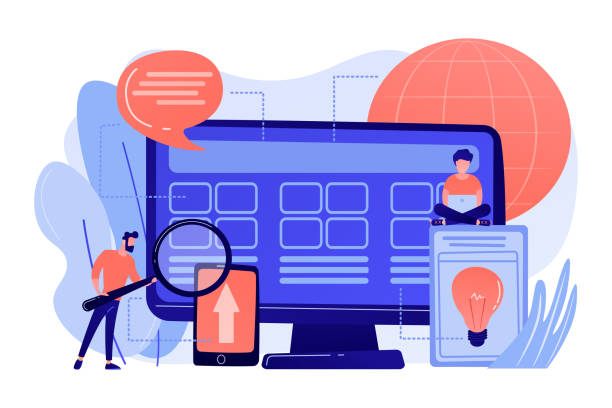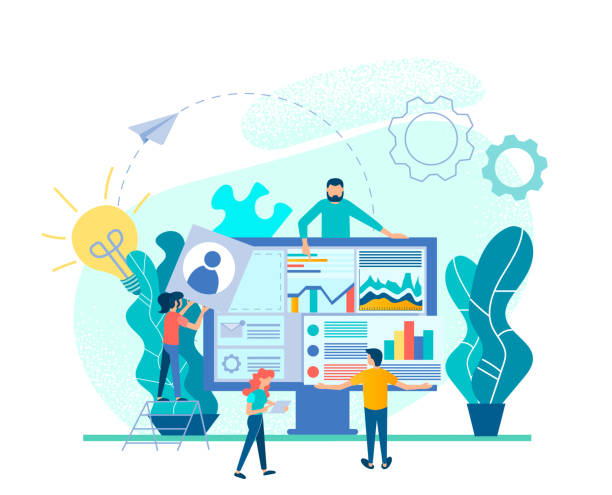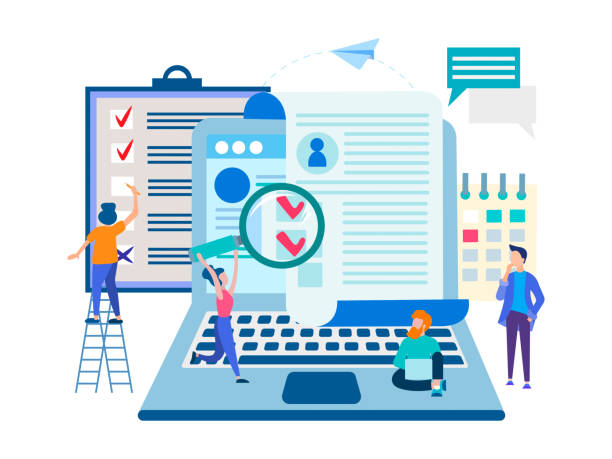Introduction and Necessity of Rapid Website Design

In today’s digital world, speed is paramount.
#Rapid_website_design is no longer a luxury option, but a vital necessity for any business that wants to compete and succeed in the online space.
Today’s users are more impatient than ever and expect web pages to load in a fraction of a second.
If your site is slow, not only will you lose users, but your ranking in search engines will also be severely affected.
It is an undeniable fact that search engines like Google prioritize fast websites.
Strong SEO begins with high site speed.
This includes not only fast content loading but also quick responsiveness to user actions.
Therefore, investing in creating a fast-loading website will directly lead to an increase in conversion rates and improved user experience.
Slow websites can easily destroy business opportunities, as users leave before they even see your content.
The importance of high-speed website design has become clearer than ever for business owners.
Given these explanations, it is clear why special attention should be paid to this aspect of web development.
Falling behind in competition with large online stores?
Rasaweb, with professional e-commerce website design, brings your business online and increases your market share!
✅ Increase brand credibility and customer trust
✅ Easy shopping experience leads to more sales
⚡ Contact us now for a free website design consultation!
Key Factors Affecting Site Speed

#Site_speed_optimization requires a deep understanding of multiple factors that influence it.
Among the most important of these factors are hosting quality, website code optimization, the size and type of images and media, and the use of caching mechanisms.
A powerful and optimized server can significantly impact the initial loading speed of a site, while heavy and unoptimized code will slow it down, even with the best server.
Proper image management, such as compression and using modern formats like WebP, can drastically reduce the overall page size and greatly contribute to rapid website design.
Additionally, the use of Content Delivery Networks (CDNs) to deliver content from the server closest to the user plays a vital role in reducing latency and increasing speed.
Techniques like minimizing HTTP requests, Gzip compression, and Lazy Loading are also specialized solutions used to improve overall website performance.
All these factors work together to provide a smooth and fast user experience, which not only satisfies users but also helps improve SEO rankings and ultimately business success.
These are the fundamental principles for any type of rapid website design.
Optimizing Images and Media in Rapid Website Design

Images and media are often the biggest culprits for slowing down websites.
#Image_optimization is an essential step in the rapid website design process.
First, choosing the right image format is crucial.
Formats like JPEG are suitable for complex photographs, and PNG for images with transparency or simpler graphics.
However, using next-generation formats like WebP can significantly reduce file sizes without noticeably affecting visual quality.
Second, compressing images before uploading, using online tools or desktop software, can reduce their size by up to 80 percent.
Third, image dimensions should be proportionate to their display size on the website; uploading excessively large images and then resizing them with CSS, creates additional load.
Finally, implementing Lazy Loading for images and videos that are not immediately in the user’s viewport ensures that only visible content is loaded initially, significantly increasing the site’s initial speed.
These approaches not only contribute to rapid website design but also improve the overall user experience.
| Optimization Method | Description | Impact on Speed |
|---|---|---|
| Using WebP Format | Modern format with better compression and similar quality to JPEG/PNG. | Very High |
| Lossless Compression | Reduces file size without losing important visual details. | High |
| Lazy Loading | Images load only when they enter the user’s viewport. | High |
| Proper Resizing | Using the exact dimensions required for image display. | Moderate |
Choosing Suitable Hosting and its Impact on Rapid Website Design

Choosing suitable hosting is the backbone of any fast website.
#Suitable_hosting plays a vital role in the overall performance of a website.
Even if your site is fully optimized in terms of coding and its images are compressed, a weak host can nullify all your efforts for rapid website design.
There are various types of hosting, including shared hosting, VPS (Virtual Private Server), dedicated server, and cloud hosting.
Shared hosting is usually the cheapest option, but its resources are divided among several websites, which can lead to reduced speed during peak hours.
VPS offers more control over server resources and settings and is a balanced option for many businesses.
Dedicated servers and cloud hosting are more expensive but provide maximum performance and flexibility, ideal for high-traffic websites or complex applications.
When choosing hosting, pay attention to factors such as bandwidth, disk space (SSD is recommended), server location (proximity to your audience), and technical support.
A high-quality hosting service can make a significant difference in your website’s loading speed and stability, ensuring success in rapid website design.
Are your online sales not as expected? With Rasaweb, permanently solve the problem of low sales and poor user experience!
✅ Increase visitor-to-customer conversion rate
✅ Create an enjoyable user experience and boost customer trust
⚡ Contact us now for a free consultation!
The Role of Optimized Coding in Site Speed

Optimized coding is one of the most important pillars of #rapid_website_design.
#Optimized_coding includes several aspects, each directly impacting web page loading speed.
The first step is reducing the size of CSS and JavaScript files through minification.
This involves removing extra spaces, comments, and unnecessary characters from the code.
Second, combining CSS and JavaScript files to reduce the number of HTTP requests.
Each HTTP request requires time to send and receive a response from the server, so reducing their number directly increases speed.
Third, ensuring that unnecessary JavaScript codes are loaded asynchronously (async or defer) to minimize render-blocking.
Fourth, optimizing database queries and ensuring they run efficiently.
Inefficient queries can significantly increase server response time.
An experienced programmer in rapid website design always pays attention to these points.
Finally, using lightweight and optimized frameworks and libraries is also important.
Choosing the right tools and adhering to Clean Code principles not only helps site speed but also makes its future maintenance and development easier.
Code optimization is not just a technical skill, but a mindset for achieving maximum efficiency.
Site Speed Testing Tools and Techniques

After implementing rapid website design solutions, #site_speed_testing is the next crucial step.
These tools help you identify your site’s performance strengths and weaknesses and plan precisely for its improvement.
Popular and reputable tools like Google PageSpeed Insights, GTmetrix, and Pingdom Tools provide valuable information about loading speed, Time To First Byte (TTFB), and suggested optimizations.
Google PageSpeed Insights operates based on Google’s Core Web Vitals metrics and provides a score for your site’s performance on mobile and desktop, along with improvement suggestions.
GTmetrix offers very detailed reports, including full load time, number of requests, and a waterfall chart of loaded resources.
Pingdom Tools also provides a good overview of load time and page size.
Additionally, using browser tools like Lighthouse in Google Chrome or Firefox Developer Tools allows you to inspect site performance in real-time.
Accurate analysis of these reports and acting upon their recommendations illuminates your path to achieving a high-speed website.
Continuity in testing and optimization is an integral part of a successful strategy for maintaining rapid website design.
The Importance of Caching and CDN for Increasing Site Speed

One of the most powerful techniques for achieving #rapid_website_design is the use of #caching and #CDN.
Caching means temporarily storing a copy of your site’s content closer to the user or in their browser’s memory.
This eliminates the need to reload all content from the main server on subsequent visits, significantly increasing loading speed.
There are various types of caching, including Browser Cache, Server-side Cache, and Object Cache for databases.
Each of these methods helps optimize a part of the loading process.
On the other hand, a Content Delivery Network (CDN) is a global network of servers that store copies of your site’s static content (such as images, CSS, JS) at different geographical points.
When a user visits your site, the content is delivered from the closest CDN server to them, which drastically reduces latency and provides a much faster user experience.
The correct combination of caching and CDN can amazingly increase site loading speed and is essential for websites with high traffic or global audiences.
These two techniques complement each other in achieving the goal of rapid website design.
| Type | Functionality | Advantages | Disadvantages |
|---|---|---|---|
| Browser Cache | Stores files on the user’s device for subsequent visits. | Increased speed for recurring visitors, reduced server load. | Effective only for subsequent visits, users can clear cache. |
| Server-side Cache | Stores generated web pages on the server. | Reduced server response time, effective for all visitors. | May not update dynamic content, requires server configuration. |
| Content Delivery Network (CDN) | Distributes content across servers close to global users. | Reduced global latency, increased stability and security. | Increased costs, requires DNS configuration. |
Site Security and Speed: An Inseparable Connection

Many assume that #site_security and #rapid_website_design are two separate topics, but in reality, they are deeply intertwined.
A secure website typically uses more optimized protocols like HTTPS, which itself aids in loading speed.
The use of an SSL/TLS certificate, which is necessary for HTTPS, not only encrypts data but also improves communication speed between the browser and server by enabling HTTP/2 and HTTP/3.
However, it should be noted that some heavy security measures, such as Web Application Firewalls (WAFs) or continuous security scans, can create overhead and reduce speed.
The challenge lies in finding the right balance between strong protection and optimal performance.
Choosing security solutions designed for minimal impact on speed, such as CDNs with built-in security features, can be very effective.
Additionally, regular maintenance and updates of Content Management Systems (CMS) and plugins not only ensure security but also prevent performance issues caused by outdated or vulnerable code.
This is a crucial aspect that must always be considered in the discussion of site design and speed optimization.
A fast but insecure site will soon face serious problems.
Does your current e-commerce website design not generate the sales you expect?
Rasaweb is an expert in professional e-commerce website design!
✅ An attractive and user-friendly site aimed at increasing sales
✅ High speed and security for an ideal shopping experience⚡ Get a free online store design consultation with Rasaweb now!
Long-Term Strategies for Maintaining Site Speed

Achieving #rapid_website_design is just a starting point; #maintaining_site_speed in the long term requires a continuous and dynamic strategy.
Websites are living entities that, over time and with the addition of new content, plugins, and software updates, may lose their initial speed.
One of the most important strategies is continuous monitoring of site performance using tools like Google Search Console or speed testing tools mentioned earlier.
Setting alerts for sudden drops in speed can help you identify problems before they impact user experience.
Regular updates of CMS, themes, and plugins are not only essential for security but often include performance optimizations as well.
Periodic cleanup of the database from excess information and spam, as well as optimizing new media files, are other important measures.
Regularly checking server logs and identifying resources that create the most load can help pinpoint potential bottlenecks.
Investing in a knowledgeable and responsive technical support team is also invaluable for quick maintenance and troubleshooting.
This is an ongoing commitment that helps maintain your competitive edge in the online space and ensures the continuity of rapid website design.
The Future of Rapid Website Design and New Trends

The future of #rapid_website_design is tied to new trends that are constantly evolving.
#New_trends in web development are moving towards super-fast and seamless user experiences.
Technologies like Progressive Web Apps (PWAs), which offer a combination of the best features of web and mobile applications, allow users to view sites offline and have a very smooth user experience.
The emergence of Web3 and blockchain technology may also bring new models of hosting and content delivery that could potentially lead to greater speed and security.
Serverless and Edge Computing are other emerging technologies that, by executing code at the closest point to the user and eliminating the need for server management, can have a tremendous impact on speed and scalability.
Artificial intelligence (AI) will also play an increasing role in automatically optimizing images, code, and even predicting website traffic for optimal resource allocation.
These developments show that the approach to high-speed website design is constantly evolving and requires up-to-date knowledge and flexibility to adapt to these changes.
A future where every website loads at lightning speed is not out of reach.
Frequently Asked Questions
| Question | Answer |
|---|---|
| What does rapid website design mean? | Optimizing a website for fast page loading in users’ browsers, which leads to a better user experience and higher search engine rankings. |
| Why is site loading speed important? | Increases user satisfaction, reduces bounce rate, improves SEO, and increases conversion rates, as users expect sites to open quickly. |
| What factors affect site speed? | Image size, unoptimized coding (CSS, JS, HTML), inappropriate hosting choice, lack of caching, high number of HTTP requests, and lack of CDN usage. |
| How can site loading speed be improved? | Compressing images, optimizing and minifying code, using caching, enabling Gzip compression, using a CDN, and choosing powerful hosting. |
| What is CDN and how does it help site speed? | A CDN (Content Delivery Network) stores website content on various geographical servers, and the closest server to the user delivers the content, which reduces loading time. |
| What is the role of hosting in site speed? | Very significant. Powerful and suitable hosting with sufficient resources, high bandwidth, and optimized servers forms the foundation of a website’s speed. |
| How does image optimization affect site speed? | Images are usually the heaviest part of a web page. Compressing and optimizing them without significant loss of quality drastically reduces page size and increases loading speed. |
| Does site speed affect SEO? | Yes, Google and other search engines consider site speed as one of the ranking factors. Faster sites have a better chance of ranking higher. |
| What tools are available to measure site speed? | Google PageSpeed Insights, GTmetrix, Pingdom Tools, and Lighthouse, each providing reports and suggestions for speed improvement. |
| How does Caching help site speed? | Caching allows static site content to be stored for subsequent user visits. As a result, the browser does not need to re-download all content, and pages load much faster. |
And other services of Rasaweb Advertising Agency in the field of advertising
Smart Digital Advertising: An effective tool for online growth with the help of key page optimization.
Smart SEO: An effective tool for online growth with the help of Google Ads management.
Smart Sales Automation: A combination of creativity and technology to improve SEO ranking through SEO-driven content strategy.
Smart Data Analysis: A creative platform for improving SEO ranking with Google Ads management.
Smart Direct Marketing: Revolutionize click-through rates with attractive UI design.
And over hundreds of other services in internet advertising, advertising consultation, and organizational solutions
Internet Advertising | Advertising Strategy | Advertorials
Resources
Benefits of Rapid Website DesignSmart Investment in Website DesignWhy is Rapid Website Design Important?Quick Start Guide for Website Design
At Rasaweb Afarin Digital Marketing Agency, we help your business shine in today’s competitive world and achieve its goals. From multilingual website design to search engine optimization and social media management, we are with you to ensure a powerful online presence.
📍 Tehran, Mirdamad Street, next to Central Bank, Southern Kazeroun Alley, Ramin Alley, No. 6



